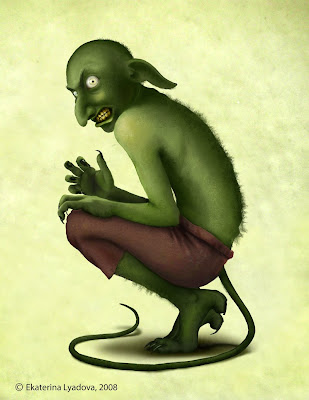
“In a time before memory, predating the Pyramids, the Sphinx and even ancient Atlantis… from the mists of an earlier age of humankind…there were unicorns, giants, and a race of tall, beautiful superior beings who came to us from another world beyond our skies.
They dwelt among us, and finding our women fair to look upon, joined with them, creating offspring. These star-children became the heroes of old, subject of legend, lore and fable, and leaders of humankind.
With the biogenetic knowledge of their forebears, they began to experiment with mixing the species. This led to the legends of the centaur, the Minotaur, the griffin and other hybrid beings, terrible servants of cruel masters."
Ms. Lyadova began by thumbnailing rough ideas, and then worked out her conception of a long-eared creature with a whiplike tail.
 According to Gary Richardson, above, a faculty member and program coordinator who prepared the new curriculum for the School of Media Studies and Information Technology, “this is part of a sequence of lessons beginning with thumbnailing and roughing out figures and composition, to story/script outline development, to character design, set design, and finally, a storyboarded sequence.”
According to Gary Richardson, above, a faculty member and program coordinator who prepared the new curriculum for the School of Media Studies and Information Technology, “this is part of a sequence of lessons beginning with thumbnailing and roughing out figures and composition, to story/script outline development, to character design, set design, and finally, a storyboarded sequence.”Mr. Richardson is dedicated to the value of traditional drawing and painting skills, and is himself a student of classic instructional texts like Bargue, Loomis, and the Famous Artists’ Course.
The students work from casts and the live model, and develop a familiarity with perspective, color theory, anatomy, and composition before they move on to mastering digital skills.
“Initially there’s some resistance to accepting traditional approach,” he said, “But once they adopt it, it does so much to advance their skill set.”
 After my slide lecture, I did a sketch demo with water-soluble colored pencils. I drew an old brass samovar in a small sketchbook, with the sketch blown up onto a giant TV screen.
After my slide lecture, I did a sketch demo with water-soluble colored pencils. I drew an old brass samovar in a small sketchbook, with the sketch blown up onto a giant TV screen. Humber is transitioning to a degree granting institution, offering 4-year degrees, 2 and 3-year diplomas, and an array of graduate certificates. It prides itself in 91% job placement for its graduates. There are 17,000 full- and part-time students in the college overall, and about 3,000 in the Media Studies program. The art program prepares students for traditional illustration, animation, or web-based opportunities.
Humber College's Visual and Digital Arts Diploma Program curriculum can be seen at:,Link.







4 comments:
Jim,
It may be too late to mention this, but reading your excellent post about Humber College reminded me you were near the McMichael Gallery. If you haven't been there, it's worth the short trip. It's in Kleinburg, a few minutes north of Toronto, and the Humber River flows nearby. It has wonderful grounds and an extensive collection of paintings by the Group of Seven.
Humber is not only a 2 year technical college. They have many 3 and four year programs as well. My sister just finished the interior design program and she managed to get a job in January, only six months after graduating. Pretty good for these economic times. Perhaps I should have gone to Humber instead of University, because I'm am entering data at an office by day and painting in my spare time.
I picked up your books awhile ago to learn color theory and world creation, very inspiring! Really glad to have found this blog!
Thanks for the kind words, Stephen. I'm glad you're finding the blog helpful.
Josephine, thanks for mentioning that Humber is more than a 2-year college.
And Steve, we had heard about that collection, but the schedule ended up being so full with school visits that I didn't get to check out any of Tdot's legendary museums. Next time!
Post a Comment